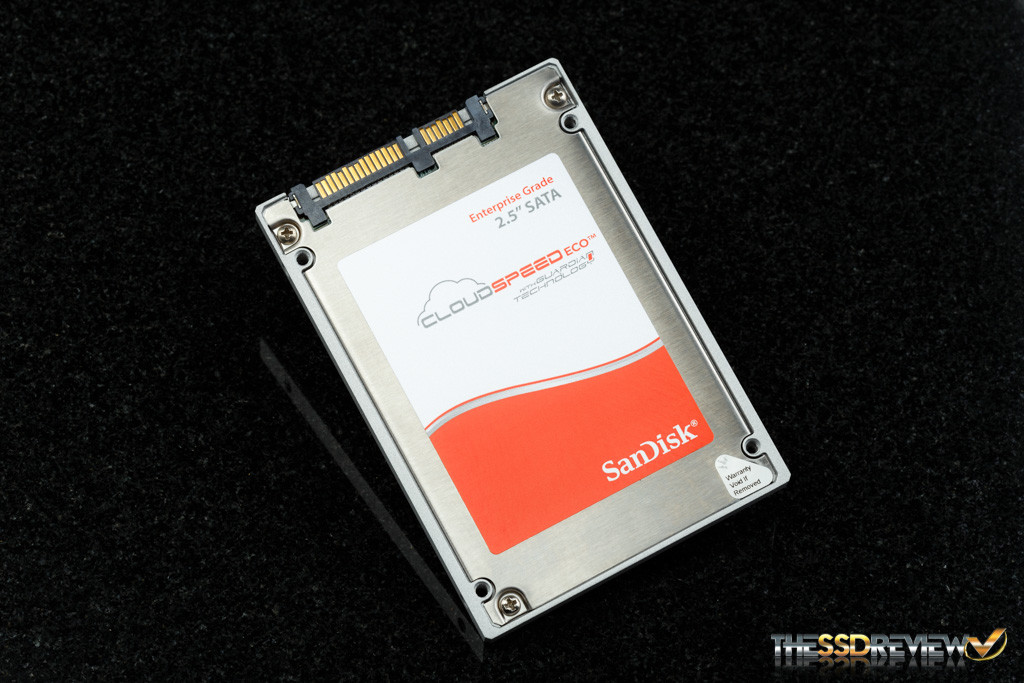When it comes to enterprise SSD storage solutions SanDisk is one of the largest manufacturers out there with a broad range of product to cover the many needs of the this ever growing market. While recent reviews have touched on products that include the words PCIe, SAS, and NVMe, where they offer breath taking performance, there are still many tasks that don’t require bleeding edge speeds and can utilize standard SATA based products. For this segment SanDisk has a trio of SATA based products built for read-intensive workloads, the CloudSpeed SSD family and today we will be taking a closer look at the 960GB CloudSpeed Eco.
The CloudSpeed Eco is essentially the base model, or runt of the litter, beyond it are two bigger brothers, the CloudSpeed Ascend and CloudSpeed Ultra. The Eco model we are testing is marketed towards as photo sharing, web servers, media streaming, video on demand (VOD), and cloud computing applications specifically. On top of read-centric performance, SanDisk engineered the CloudSpeed SSD family to be robust as well. These SSDs feature their Guardian Technology Platform to deliver, which they state, high data integrity and greater endurance than competing client SSDs.
SPECIFICATIONS, PRICING, AND AVAILABILITY
The SanDisk CloudSpeed Eco is a 2.5″ 7mm form factor SATA 6Gb/s SSD and is available in three capacities, 240GB ($313.25), 480GB ($466.14), and 960GB ($995.00). It offers sequential performance up to 475MB/s read and 450MB/s write. Random 4K IOPS are rated for up to 80K IOPS read and 14K IOPS write as stated earlier and it is specified to have access times less than 2.0ms.
In terms of reliability, the CloudSpeed Eco has a BER (bit error rate) of 1 unrecoverable error in 10^17 bits read. The MBTF rating is for up to 2 million hours. It has data fail recovery for up to 1 NAND flash erase block of data. There is also power fail recovery and temperature monitoring that will throttle performance if critical temperature is reached. Internal operating temperature is from 0-70C. It also consumes all its power off the 5v rail with active power being rated at 5.2W and idle at 2.2W.
The CloudSpeed Eco is rated for one drive write per day in terms of endurance and warranty is for the lesser of 3 years or maximum endurance reached. That equates to a maximum endurance of 262.8TB (240GB), 525.6TB (480GB), and 1.05PB (960GB).
Such endurance and reliability is achieved through their Guardian Technology Platform, which is actually three technologies working together. They are FlashGuard Technology, DataGuard Technology, and EverGuard Technology.
FlashGuard utilizes aggregated flash management, which treats all the flash as a single system rather than individual elements, and advanced signal processing combined with a mix of flash grades to ensure even wear and maximum endurance is achieved. DataGuard uses T10-DIF (Data Integrity Field) for host control and F.R.A.M.E. (Flexible Redundant Array of Independent Memory Elements) for cross-die data redundancy and recovering of data on a failed blocked page. This ensures full-data-path protection. Finally, EverGuard leverages and array of capacitors to provide ample power for the DRAM cache to flush all data into the NAND in the event of a power-loss.
INTERNAL COMPONENTS
The all-metal shell is held together by four Loctite screws and once fully disassembled we can see that this SSD is similar to many other SATA 6Gb/s based drives. There is a DRAM buffer, a single controller, and 16 NAND packages.
There is also an array of 14 tantalum capacitors used by their EverGuard Technology. The thermal pad is located on the back side of the controller on the PCB to help dissipate heat into the shell.
The CloudSpeed Eco utilizes a Marvell 88SS9189 controller and SanDisk’s 19nm cMLC (consumer MLC) NAND. Each package is 64GB in capacity for a total raw capacity of 1024GB. It is factory over provisioned it by 7%, resulting in a final capacity of 960GB and once formatted there is 894GB available to the end user.
Finally, the 960GB model’s DRAM cache size is 1GB spread across two 512MB Micron DDR3-1600 DRAM chips.
 The SSD Review The Worlds Dedicated SSD Education and Review Resource |
The SSD Review The Worlds Dedicated SSD Education and Review Resource | 

